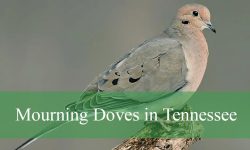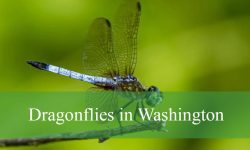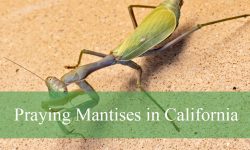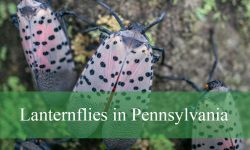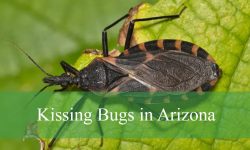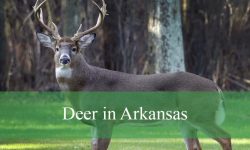Oklahoma is home to a wonderful variety of birds, from tiny hummingbirds to large, soaring hawks. Whether you’re exploring prairies, forests, or your own backyard, you’re likely to spot some familiar feathered friends.
This guide introduces 45 common birds found across the state. With pictures and identification tips, it’s perfect for beginners and casual birdwatchers who want to better recognize the birds they see every day.
Types of Birds Found in Oklahoma
American Robin
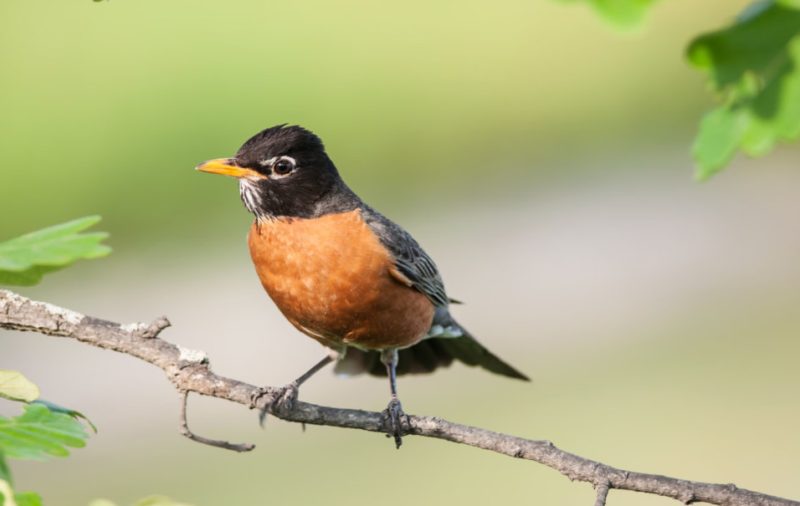
The American Robin (Turdus migratorius) is a familiar and beloved bird recognized by its bright orange-red breast, grayish-brown back, and cheerful song. It measures about 9–11 inches long with a wingspan of 12–16 inches. Both males and females look similar, though males may have slightly more vibrant coloration. Their dark eyes and yellow bills further aid identification.
Robins are among the first birds to sing at dawn, often heard before sunrise in Oklahoma neighborhoods, parks, and woodlands. While they are partially migratory, many stay in Oklahoma year-round, especially if food sources like berries are available. They feed on earthworms, insects, and fruit, often seen hopping across lawns and stopping to tug worms from the soil. During breeding season, they build mud-lined nests and usually raise two or three broods per year.
An interesting fact about American Robins is that they can produce up to 20 distinct vocalizations, including alarm calls, mating calls, and a complex song. Their presence often signals the arrival of spring, and their melodic, warbling tunes are a classic soundtrack to Oklahoma mornings. They adapt well to human presence and are often seen bathing in birdbaths or gathering nesting material from gardens.
Northern Cardinal
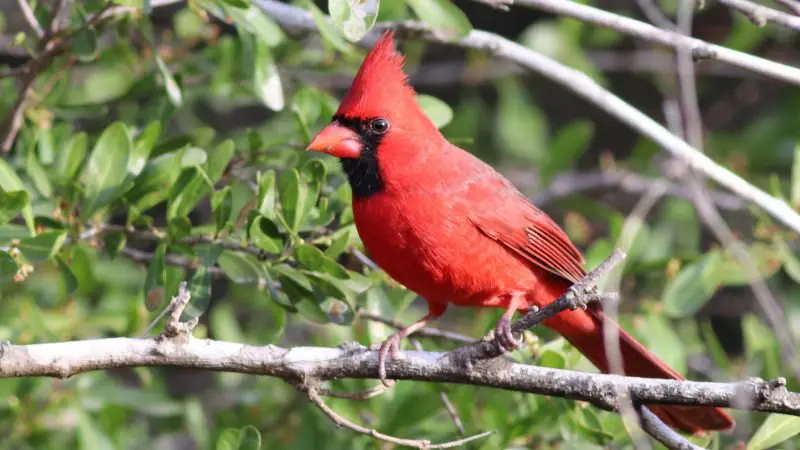
The Northern Cardinal (Cardinalis cardinalis) is a striking songbird known for its vivid red plumage in males and soft brown tones with red accents in females. Both sexes have a distinctive crest atop their heads and a short, thick, orange-red beak ideal for cracking seeds. This medium-sized bird measures about 8.3–9.1 inches in length, with a wingspan of 9.8–12.2 inches. Males are easily recognizable with their bright coloration and bold black mask around the face.
Northern Cardinals are non-migratory and found year-round throughout Oklahoma, particularly in suburban gardens, forest edges, and wooded parks. They are ground feeders, often foraging for seeds, fruits, and insects, especially during the breeding season. These birds are monogamous and raise two to three broods each year, with the female constructing a cup-shaped nest and incubating the eggs while the male provides food. Their clear, whistled songs—often described as “cheer-cheer-cheer” or “birdy-birdy-birdy”—are sung by both males and females.
A fun fact about the Northern Cardinal is that it’s one of the few North American female songbirds that sing, often responding to or coordinating with the male’s call. These birds are especially active at dawn and dusk, adding a musical charm to early mornings. In Oklahoma, they’re one of the most common backyard birds and are even more visible in winter when their red feathers contrast against snowy landscapes.
Blue Jay
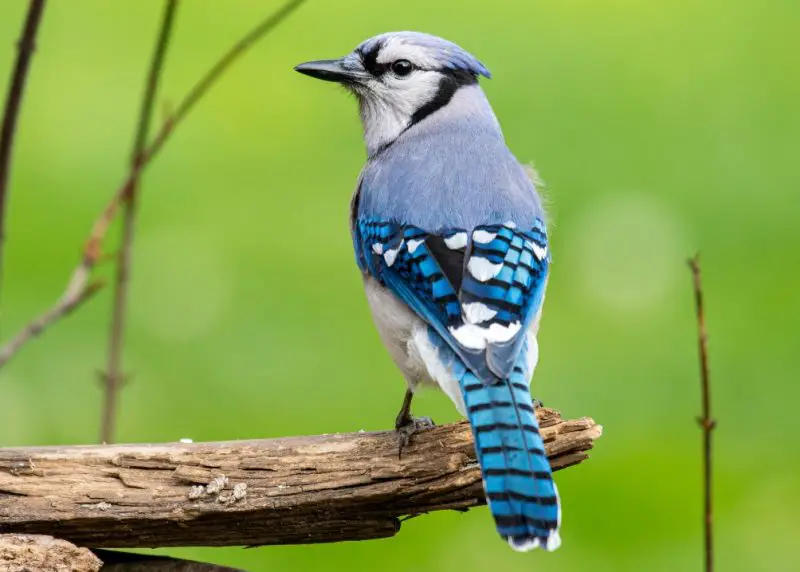
The Blue Jay (Cyanocitta cristata) is a bold and intelligent bird known for its bright blue plumage, black necklace-like markings, and loud, varied vocalizations. Measuring around 9–12 inches in length with a wingspan of 13–17 inches, Blue Jays have striking white underparts and a prominent crest. Their blue coloration, caused by light scattering in the feather structure rather than pigment, is especially vibrant in sunlight.
Blue Jays are common year-round residents in Oklahoma, particularly in oak forests, suburban yards, and wooded urban areas. They are omnivores, feeding on acorns, insects, nuts, seeds, and occasionally small vertebrates or nestlings. Blue Jays are known for their complex social behavior and mimicry skills, sometimes imitating hawk calls to deter other birds from feeders. They’re also notable for caching food, especially acorns, to consume later.
A fun fact about Blue Jays is their role in forest regeneration—they often forget where they buried acorns, inadvertently planting trees. Their calls include harsh “jay-jay” sounds, musical whistles, and even mimicry of other species. Their intelligent behavior and vibrant appearance make them a favorite among Oklahoma birdwatchers and backyard birders.
Mourning Dove
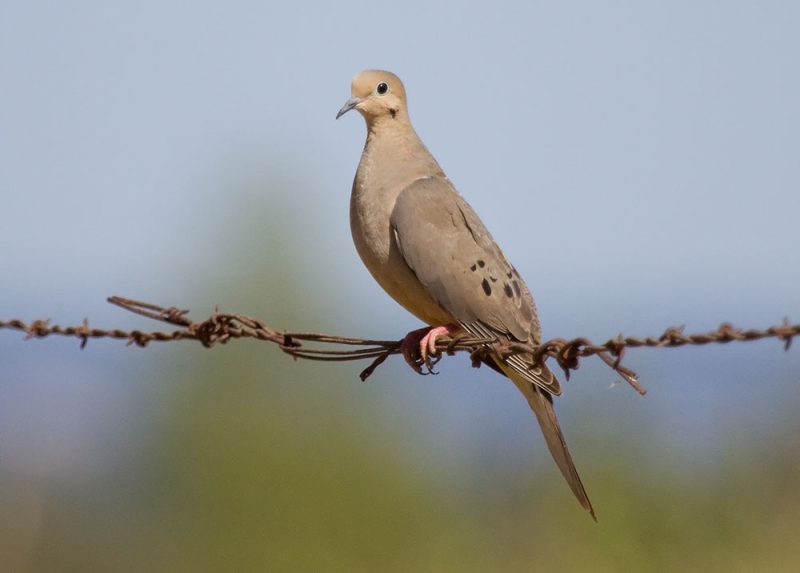
The Mourning Dove (Zenaida macroura) is a slender, graceful bird with a soft grayish-brown body, small head, and long, pointed tail edged in white. It measures about 9–13 inches in length with a wingspan of 17–18 inches. Their subtle beauty is enhanced by iridescent feathers on the neck and delicate black spots on the wings.
These gentle doves are widespread in Oklahoma, inhabiting open fields, city parks, farmlands, and suburban neighborhoods. They feed mainly on seeds, often seen pecking at the ground beneath feeders. Mourning Doves are prolific breeders, sometimes raising up to six broods per year in the warmer climate of Oklahoma. Their nests are fragile-looking platforms of twigs, typically built in shrubs, trees, or even hanging flowerpots.
The species gets its name from its soft, mournful cooing, a haunting and familiar sound across Oklahoma landscapes. Despite their fragile appearance, Mourning Doves are strong fliers, capable of swift, darting flight that produces a distinctive whistling sound from their wings. They are one of the most hunted game birds in North America, but their high reproductive rate keeps populations stable.
Red-tailed Hawk
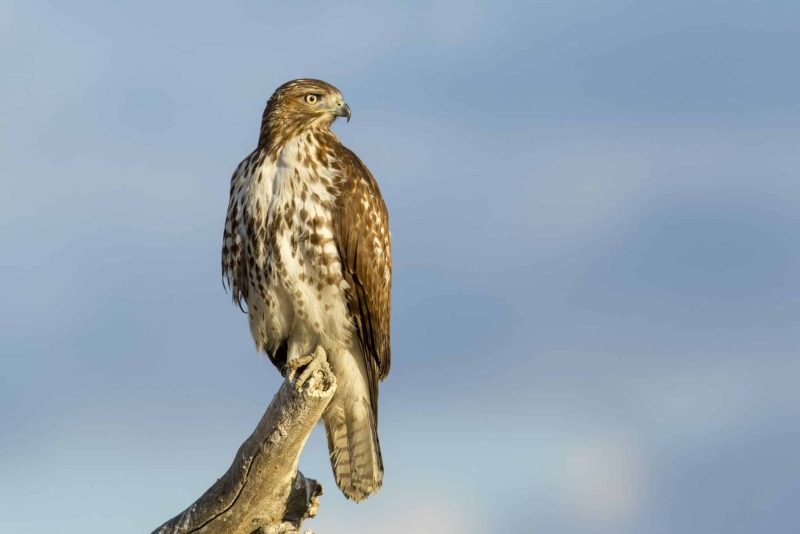
The Red-tailed Hawk (Buteo jamaicensis) is one of the most recognizable birds of prey in North America, including Oklahoma. Adults typically measure 18–26 inches in length with a wingspan ranging from 43 to 57 inches. Their plumage can vary, but most have a rich brown back, pale underparts, and a characteristic brick-red tail that is especially visible in flight. Their broad wings and short, wide tail make them powerful gliders.
Red-tailed Hawks are year-round residents in Oklahoma, commonly seen soaring above open fields, perching on telephone poles, or circling in the sky in search of prey. They primarily feed on small mammals like rabbits, squirrels, and rodents, using their keen eyesight to detect movement from great distances. These hawks are monogamous and often return to the same nest site year after year, usually high in a tall tree or cliff ledge.
Their call is a raspy, descending scream—“keeeeer”—that’s frequently used in movies to represent all raptors, regardless of species. A fascinating fact about Red-tailed Hawks is that immature birds lack the iconic red tail, which develops after their first molt. In Oklahoma, they are a familiar presence throughout the year and a key part of the state’s open-country and prairie ecosystems.
Eastern Bluebird
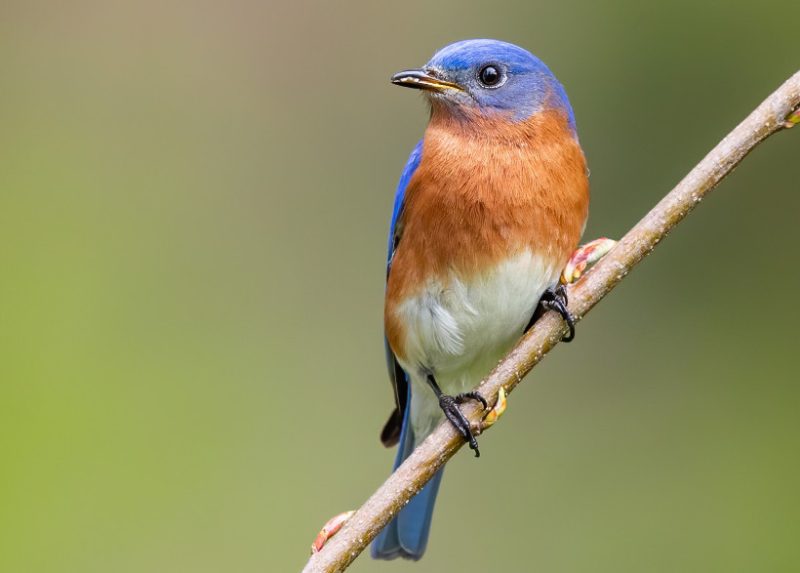
The Eastern Bluebird (Sialia sialis) is a small, colorful thrush easily recognized by its bright blue back, rusty red throat and chest, and white belly. Males are more vibrant, while females have a softer, grayer tone but retain the same overall pattern. These birds typically measure 6.3–8.3 inches in length with a wingspan of 9.8–12.6 inches. Their gentle appearance and soft warbling calls make them a favorite among birdwatchers.
Eastern Bluebirds are common throughout Oklahoma’s open woodlands, meadows, pastures, and suburban areas, particularly where nest boxes are available. They rely on cavities for nesting and will readily use artificial nest boxes. Their diet consists mostly of insects during the warmer months and fruits or berries in winter. Bluebirds are known for their gentle, fluttering flight and perch-hunting behavior, often scanning for prey from fences or branches.
A fun fact is that Eastern Bluebirds were once in serious decline due to competition from non-native species like House Sparrows and European Starlings, but conservation efforts, especially nest box programs, have helped their numbers rebound. Their melodious song is a soft, whistled series of short notes that brings a peaceful quality to spring mornings in Oklahoma’s countryside.
Carolina Wren
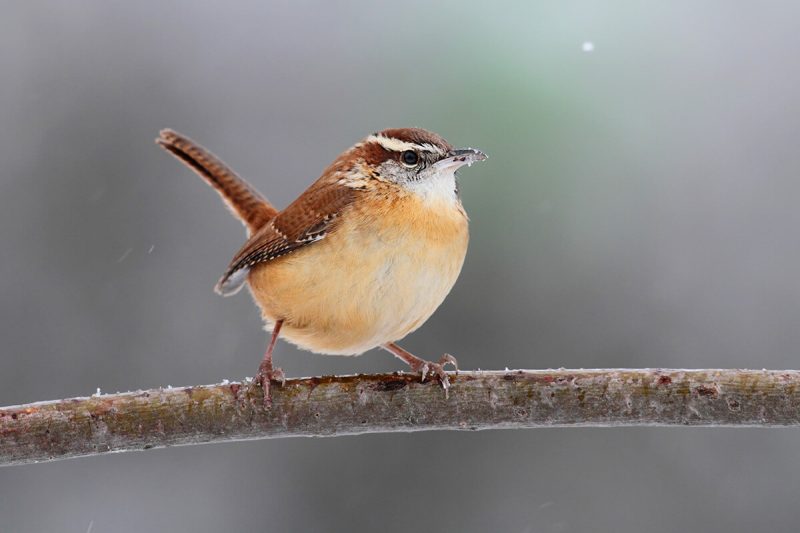
The Carolina Wren (Thryothorus ludovicianus) is a small, energetic bird with a loud voice and a perky attitude. It has warm reddish-brown upperparts, a buffy-orange underside, and a bold white eyebrow stripe. Measuring about 4.7–5.5 inches in length with a wingspan of around 11 inches, it is stocky with a slightly curved bill and a short tail often held upright.
This species is a year-round resident across Oklahoma, especially in dense shrubs, thickets, suburban yards, and brushy woodlands. Carolina Wrens are insectivorous, probing bark crevices and leaf litter for insects and spiders, though they will also eat seeds and suet in winter. Pairs stay together all year and build domed nests in sheltered areas, including hanging pots, mailboxes, or garage shelves.
One surprising fact is that the Carolina Wren’s song is impressively loud for its size—it often sounds like a much bigger bird. Males sing a series of clear, repeated whistles such as “teakettle-teakettle-teakettle,” sometimes changing their songs throughout the year. Their bold behavior and curious nature make them a delightful presence in Oklahoma gardens and woodlands.
House Sparrow
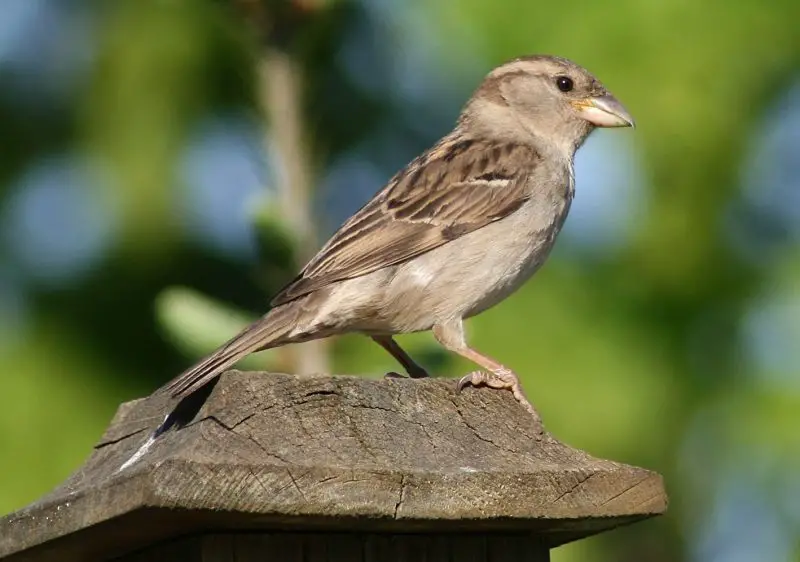
The House Sparrow (Passer domesticus) is a small, chunky bird with a stout bill, found commonly around human habitation. Males have gray heads, white cheeks, and a distinctive black bib, while females are more subdued in color, with brown streaked backs and pale undersides. These birds are about 5.9–6.7 inches long with a wingspan of 7.5–9.8 inches.
Originally from Europe and introduced to North America in the 1850s, House Sparrows have thrived in urban and suburban areas across Oklahoma. They are social, opportunistic feeders that eat a wide variety of foods, including seeds, grains, and human scraps. These birds often nest in building crevices, streetlights, and vents, building messy nests of straw, paper, and feathers.
A notable fact about House Sparrows is their aggressive behavior toward native cavity-nesting birds like bluebirds and wrens. They’re highly adaptable and can be seen in noisy flocks around parking lots, fast food restaurants, and farms. Though often considered a nuisance, they have become an integral part of urban soundscapes, filling the air with their constant chirps and chatter.
American Crow
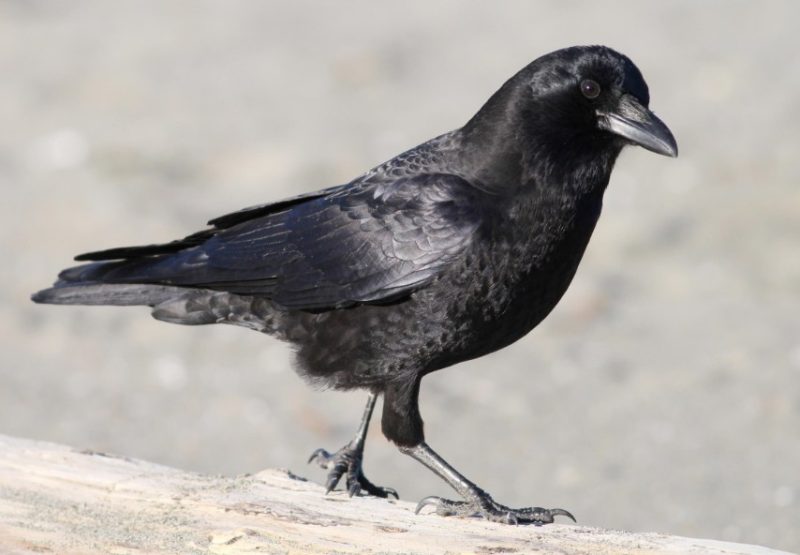
The American Crow (Corvus brachyrhynchos) is a large, glossy-black bird known for its intelligence, adaptability, and loud cawing voice. Measuring 16–21 inches in length with a wingspan of 33–39 inches, they have strong bills, fan-shaped tails, and sturdy legs. Their black feathers may show hints of iridescent purple or green in bright sunlight.
American Crows are widespread across Oklahoma in both rural and urban areas, including woodlands, agricultural fields, and city parks. They are omnivorous and opportunistic, feeding on everything from insects and small animals to grains, carrion, and garbage. Highly social, they often form large roosts and family groups. During the breeding season, both parents and older siblings may help feed the young.
An interesting fact is that American Crows can recognize individual human faces and even hold grudges or pass learned information to others in their group. Their “caw-caw” calls serve multiple purposes, from alarm to communication within flocks. In Oklahoma, crows play an important ecological role as scavengers and are often observed walking confidently across fields or perching on tree branches, watching with curiosity.
Downy Woodpecker

The Downy Woodpecker (Dryobates pubescens) is the smallest woodpecker in North America, measuring just 5.5–6.7 inches long with a wingspan of 9.8–11.8 inches. It has a white belly, black-and-white patterned wings, a white back, and a black cap. Males have a small red patch on the back of the head, while females do not. Its straight bill appears small relative to its head size, helping distinguish it from the similar Hairy Woodpecker.
These woodpeckers are year-round residents in Oklahoma, frequenting deciduous forests, wooded suburbs, orchards, and even city parks. They forage by tapping and probing bark for insects, larvae, and spiders, and will also eat berries and suet from feeders. Downy Woodpeckers nest in tree cavities and often excavate new holes each season, usually in soft or decaying wood.
A fun fact about the Downy Woodpecker is that it performs a rapid drumming display to communicate territory, rather than relying on songs like many songbirds. Despite its small size, its tapping can be surprisingly loud. In Oklahoma gardens, their presence is often welcomed for their insect control abilities and charming acrobatics as they hop along tree trunks and branches.
Northern Flicker

The Northern Flicker (Colaptes auratus) is a medium-to-large woodpecker with a distinct appearance and uncharacteristic habits for its family. Unlike most woodpeckers, flickers are often seen on the ground, foraging for ants—their favorite food. They have a brownish body with black barring on the back, a black crescent on the chest, and a spotted belly. Males in Oklahoma typically display a red patch on the nape and a black mustache mark, characteristic of the “yellow-shafted” form found in the eastern U.S.
Northern Flickers are widespread across Oklahoma in open woodlands, forest edges, grasslands, and suburban areas with scattered trees. They can be identified in flight by their white rump and yellow underwings and tail feathers, which flash brilliantly when they take off. These birds nest in tree cavities and may also use fence posts or utility poles. They drum on metal or wood surfaces to establish territory and attract mates, often producing a rapid, resonant rolling sound.
A fun fact is that Northern Flickers have one of the longest tongues of all North American birds—up to 2 inches beyond the bill—to extract ants from deep soil or wood crevices. Their call is a loud, repeating “wicka-wicka-wicka” that echoes through woodlands in spring. In Oklahoma, flickers are visible year-round, especially in areas with dead trees or open spaces where ants are plentiful.
Red-winged Blackbird
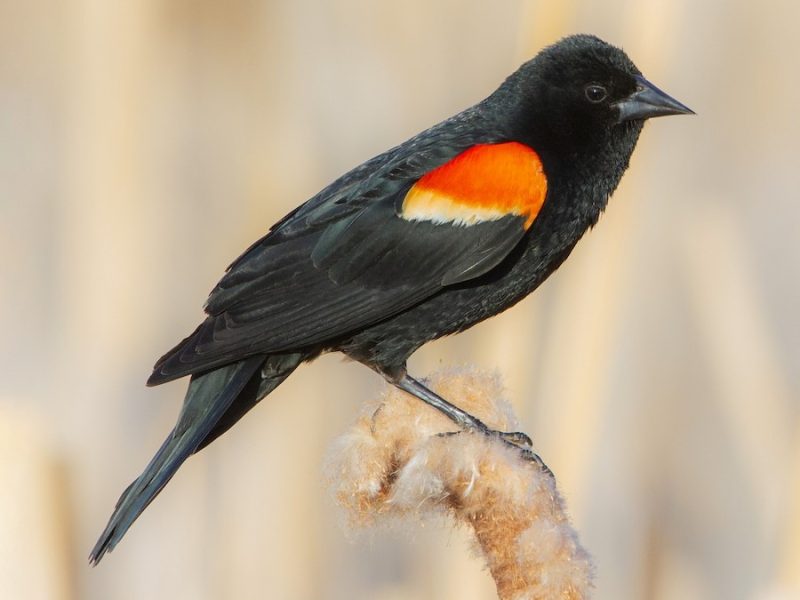
The Red-winged Blackbird (Agelaius phoeniceus) is a familiar and highly vocal bird of wetlands and open fields. Males are glossy black with striking red and yellow shoulder patches, or epaulets, which they flare dramatically when calling or defending territory. Females look quite different—streaked brown and white with a more sparrow-like appearance. These birds are about 6.7–9.1 inches long with a wingspan of 12–16 inches.
Red-winged Blackbirds are common throughout Oklahoma, especially around marshes, ponds, wet pastures, and roadside ditches. They are early nesters, often arriving before other migratory birds and setting up territories in cattails and reeds. Males are highly territorial and may mate with several females. Their gurgling, metallic song—“conk-la-ree!”—is a signature sound of spring and summer wetlands.
One fun fact is that Red-winged Blackbirds will fiercely defend their nests, even attacking much larger animals or humans that venture too close. They are social birds outside the breeding season, forming large flocks that may include other blackbird species. Their adaptability and loud, charismatic calls make them one of the most recognizable birds in Oklahoma’s wetland ecosystems.
Common Grackle
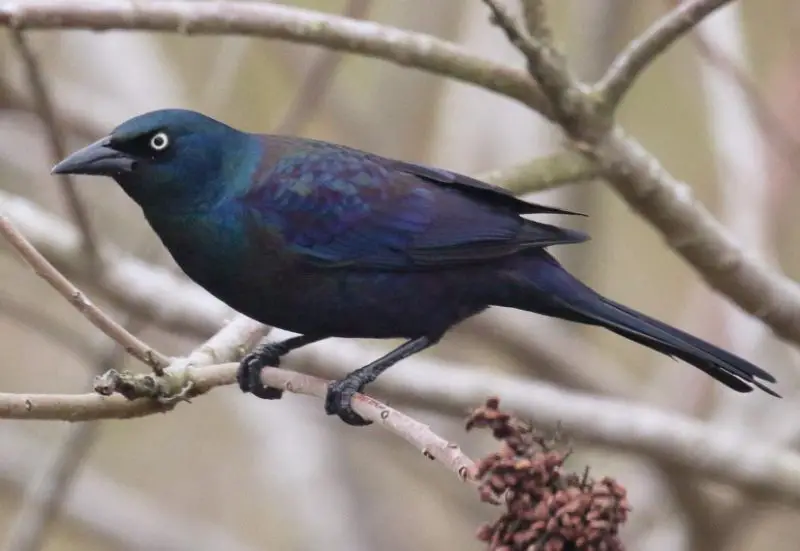
The Common Grackle (Quiscalus quiscula) is a large, iridescent blackbird with a long tail and a bold personality. It measures 11–13 inches in length with a wingspan of 14–18 inches. Males are particularly striking, with glossy black plumage that reflects hues of blue, purple, or bronze in the sunlight. Their pale yellow eyes and keel-shaped tails give them a distinctive appearance. Females are slightly smaller and duller in color.
Grackles are widespread across Oklahoma, thriving in farmlands, urban areas, parks, and wetlands. They are omnivores and will eat just about anything, from grains and seeds to insects, small fish, and even garbage. Grackles are known for their raucous calls, which include a variety of squeaks, whistles, and harsh “readle-eek” sounds. During the breeding season, males gather in noisy groups and perform exaggerated displays to attract mates.
A quirky fact about Common Grackles is that they sometimes dunk hard food items like dog kibble or stale bread in water to soften them before eating. Their intelligence and social nature make them a dominant presence in mixed flocks. In Oklahoma, large groups of grackles often gather in parking lots, trees, or fields, where their shimmering plumage and loud calls draw attention.
European Starling
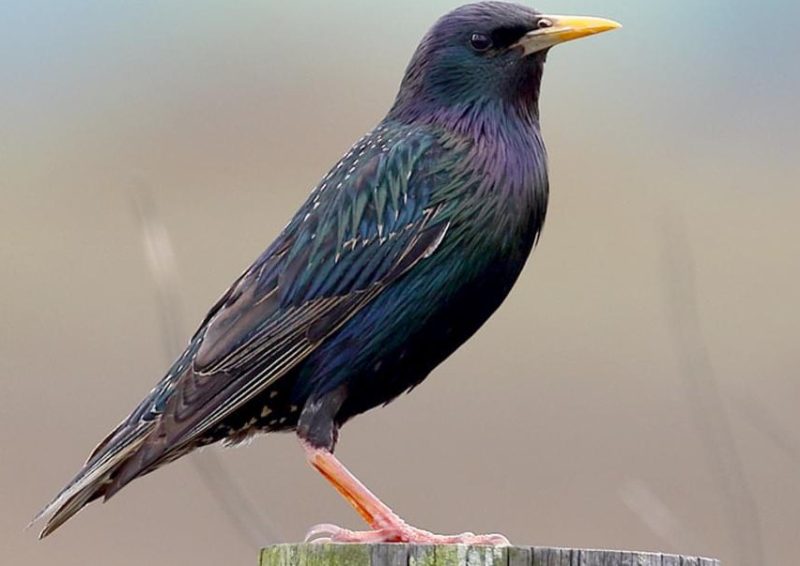
The European Starling (Sturnus vulgaris) is a medium-sized songbird with glossy black plumage speckled with white during winter and a purplish-green iridescence in summer. It measures about 7.9–9.1 inches in length with a wingspan of 12–17 inches. Its bill is yellow during breeding season and dark in winter. Though beautiful, starlings are aggressive and invasive, having been introduced to North America in the late 1800s.
European Starlings are now abundant throughout Oklahoma, thriving in cities, suburbs, farmlands, and open countryside. They nest in cavities and often outcompete native species like woodpeckers and bluebirds for nesting sites. Their diet includes insects, fruits, grains, and even food scraps. Starlings are incredibly social and form enormous flocks, known as murmurations, that twist and swirl in mesmerizing aerial displays.
A fascinating fact is that European Starlings are exceptional mimics—they can imitate other bird calls, human sounds, and even mechanical noises. Despite their status as pests, their complex vocal abilities and synchronized flocking behavior make them intriguing to observe. In Oklahoma, they are especially noticeable in winter when their large roosts can contain thousands of individuals.
Great Horned Owl
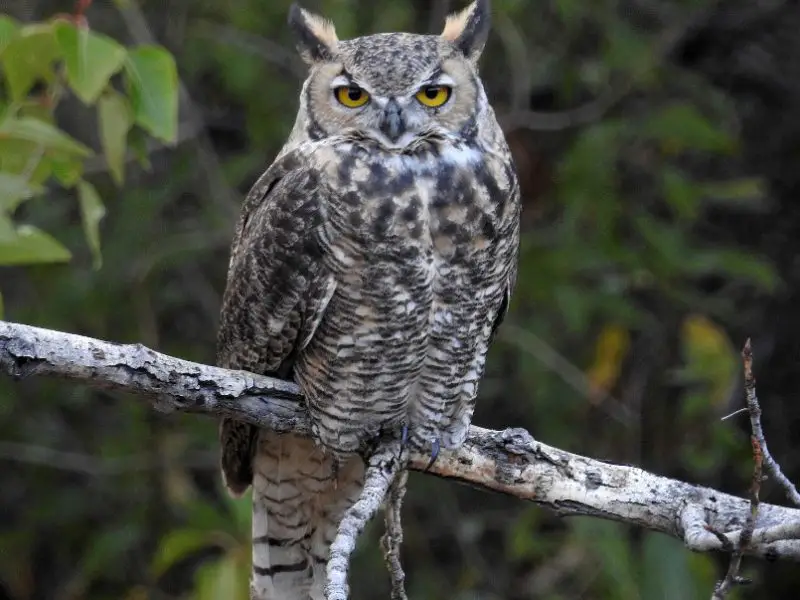
The Great Horned Owl (Bubo virginianus) is a powerful and iconic raptor known for its large size, fierce eyes, and tufts of feathers resembling horns. It measures 18–25 inches long with a wingspan of up to 60 inches. Its plumage is mottled brown and gray, providing excellent camouflage against tree bark. The large yellow eyes and deep hooting calls make this nocturnal predator instantly recognizable.
These owls are found throughout Oklahoma in forests, deserts, urban parks, and even open farmland. They are generalist predators and consume a wide range of prey, including rabbits, rodents, skunks, birds, and reptiles. Great Horned Owls typically begin nesting in late winter, often using old hawk nests or tree cavities. They are among the earliest nesting birds in Oklahoma, sometimes incubating eggs in January.
One remarkable fact is that Great Horned Owls have incredibly strong talons—capable of crushing prey with 300 pounds per square inch of pressure. Their call, a deep and resonant “hoo-hoo-hoooo hoo hoo,” is one of the most iconic sounds of the night. Despite their stealth, their haunting calls are often heard echoing across Oklahoma fields and woodlands after dusk.
Eastern Towhee
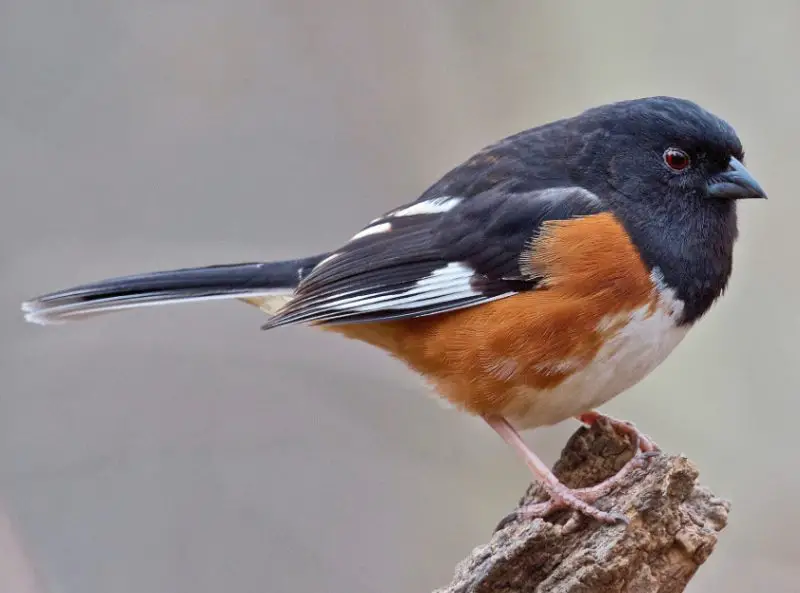
The Eastern Towhee (Pipilo erythrophthalmus) is a large, striking sparrow with bold plumage and a distinctive call. Males are mostly black above with rufous sides and a white belly, while females have the same pattern but in rich brown tones instead of black. Their bright red eyes, long rounded tails with white edges, and heavy conical bills make them easy to identify. These birds are around 6.8–9.1 inches in length with a wingspan of 7.9–11 inches.
Eastern Towhees are found year-round in eastern Oklahoma and migrate into the western parts of the state during the colder months. They favor shrubby woodlands, thickets, and overgrown fields where they forage on the ground by noisily scratching through leaves with both feet. Their diet includes seeds, insects, berries, and occasionally small invertebrates. Their call—often rendered as “drink-your-tea!”—is loud, rising, and distinctive.
A fun fact is that Eastern Towhees were once considered part of a single species with the Spotted Towhee, but they’re now recognized as separate. Their secretive behavior often keeps them hidden among dense underbrush, but their loud songs and rustling movements can give away their location. In Oklahoma, they’re most easily spotted near forest edges and tangled undergrowth.
White-breasted Nuthatch
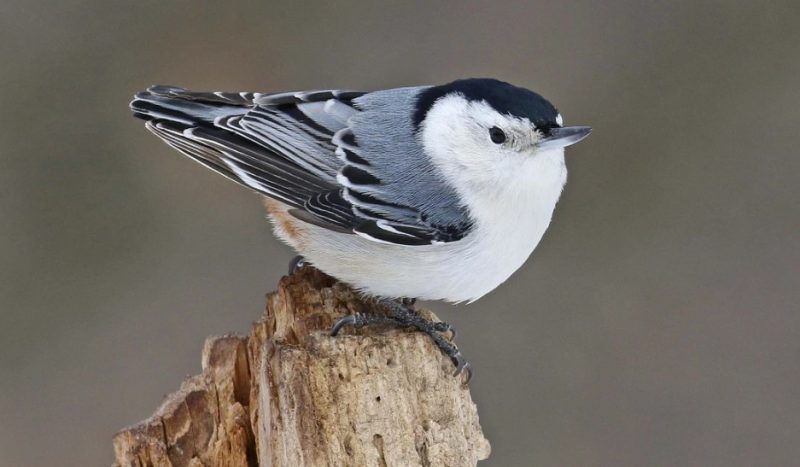
The White-breasted Nuthatch (Sitta carolinensis) is a small, agile songbird known for its habit of creeping headfirst down tree trunks. It has a crisp white face and underparts, a bluish-gray back, and a black cap that extends to the nape in males (grayer in females). Measuring 5.1–5.5 inches long with a wingspan of 7.9–10.6 inches, it has a short tail, strong feet, and a sharp, slightly upturned bill.
White-breasted Nuthatches are common year-round in Oklahoma’s woodlands, especially in mature deciduous forests and suburban areas with large trees. They feed on insects, nuts, and seeds, often storing food in bark crevices for later use. Their nasal “yank-yank” calls are frequent and easily recognizable. Nuthatches nest in tree cavities and often reuse the same spots across years.
An interesting behavior is their ability to walk both up and down tree trunks—a movement few birds can do. This gives them a different perspective when foraging, allowing them to spot insects others might miss. In Oklahoma, they’re regular visitors to feeders, especially in winter, where they enjoy sunflower seeds and suet.
House Finch
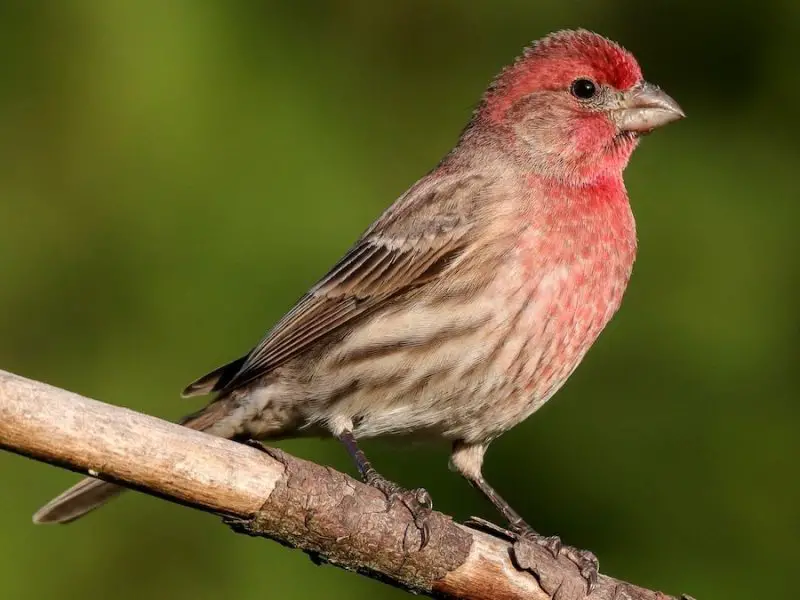
The House Finch (Haemorhous mexicanus) is a small, cheerful songbird known for its melodious song and adaptability to urban environments. Males have rosy red faces, chests, and rumps, while females are brown and heavily streaked without any red. They measure about 5–6 inches in length with a wingspan of 8–10 inches, and have relatively large beaks adapted for seed-eating.
Originally native to the western U.S., House Finches were introduced in the east and have since spread widely, including all across Oklahoma. They thrive in cities, suburbs, farmlands, and rural areas, often nesting in eaves, hanging planters, and building crevices. Their diet consists primarily of seeds and fruits, and they’re frequent visitors to backyard feeders.
One fun fact is that the red coloration in males comes from pigments in their diet, meaning the brightness of a male’s plumage can reflect the quality of his food and health. House Finches sing a long, warbling song that includes sudden sharp notes and cheerful trills. Their friendly behavior and adaptability have made them one of Oklahoma’s most abundant songbirds.
Dark-eyed Junco
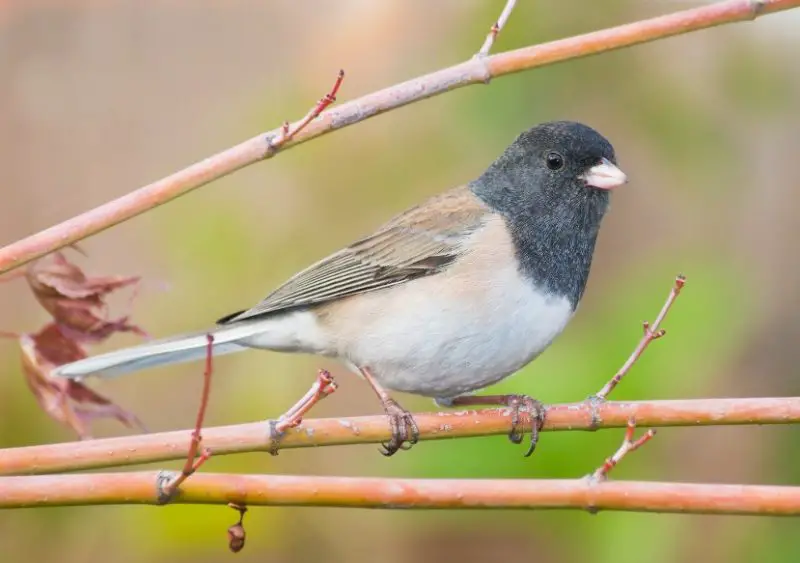
The Dark-eyed Junco (Junco hyemalis) is a small, plump sparrow with a round head and a short, pinkish bill. The most common form seen in Oklahoma—the “slate-colored” variety—has a dark gray head and upperparts, white belly, and outer white tail feathers that flash in flight. These birds measure 5.5–6.3 inches long with a wingspan of 7.1–9.8 inches.
Dark-eyed Juncos are primarily winter visitors to Oklahoma, migrating from breeding grounds farther north. They are found in woodlands, hedgerows, backyards, and open fields, usually foraging on the ground in flocks. Their diet consists of seeds, especially from grasses and weeds, supplemented with insects during the breeding season. They often hop rather than walk, giving them a charming, active appearance.
A fun fact is that Juncos are sometimes called “snowbirds” because they appear just as winter sets in. Their soft, trilling calls and quiet twittering are common in colder months. While they typically disappear from Oklahoma during spring and summer, their return each fall is a familiar sign of the changing seasons.
Brown-headed Cowbird
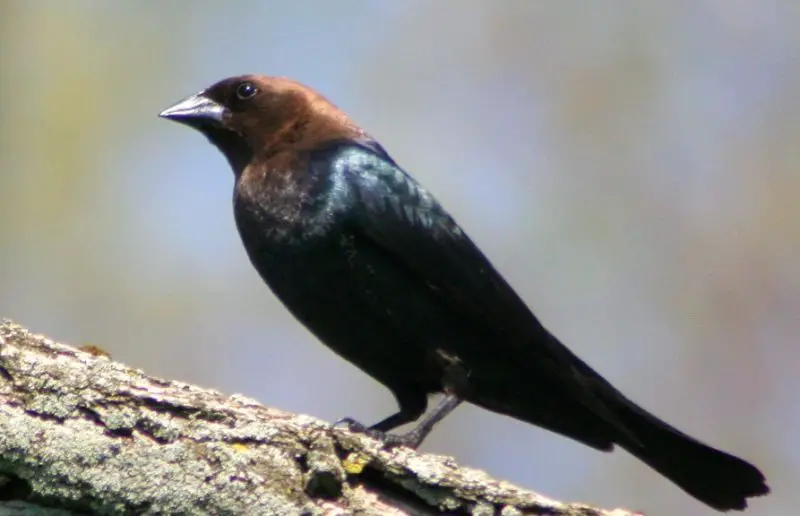
The Brown-headed Cowbird (Molothrus ater) is a medium-sized blackbird with a glossy black body and a contrasting brown head in males, while females are plain brown and more subtly streaked. These birds are about 6.3–8.7 inches long with a wingspan of 12–15 inches. They have short, thick bills and slightly rounded tails.
Brown-headed Cowbirds are common throughout Oklahoma in open fields, pastures, forest edges, and suburban areas. What sets them apart is their brood parasitism—they do not build nests but lay their eggs in the nests of other birds, often at the expense of the host’s offspring. They are generalist foragers, feeding on seeds, grains, and insects, and often seen in flocks mixed with blackbirds or starlings.
An unusual fact about Cowbirds is that they can lay eggs in up to 40 different nests in one breeding season. Some host species unknowingly raise Cowbird chicks, while others recognize and reject the foreign eggs. Despite their controversial nesting behavior, Cowbirds play a role in balancing ecosystems, and in Oklahoma they are a common sight in agricultural and grassy areas.
Western Meadowlark (Oklahoma State Bird)
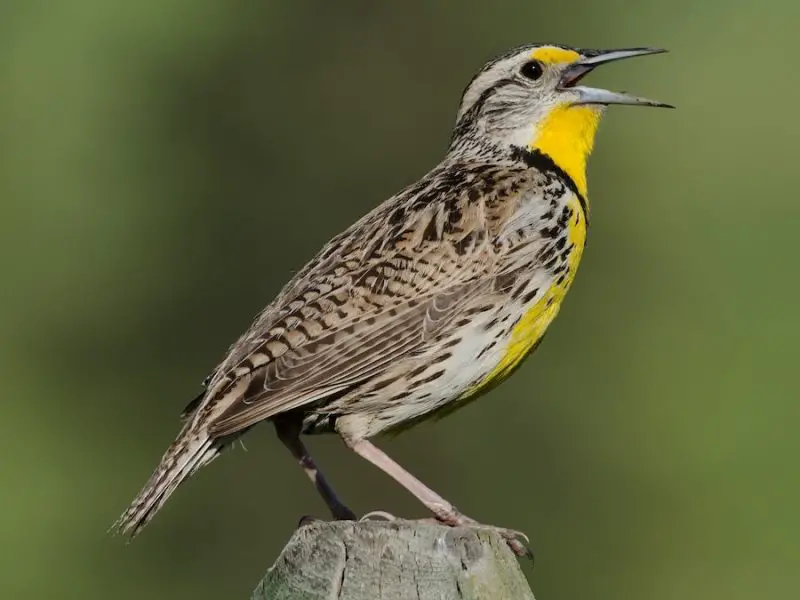
The Western Meadowlark (Sturnella neglecta) is a medium-sized songbird with a bright yellow chest adorned with a bold black “V” and a mottled brown and white back. Its short tail, long pointed bill, and pale eyebrow stripe help in identifying it from a distance. Measuring about 6.3–10.2 inches long with a wingspan of 16 inches, this bird blends well into grassland habitats when not in flight.
Named the official state bird of Oklahoma in 1937, the Western Meadowlark is commonly found in open fields, prairies, and pastures throughout the state. It feeds mostly on insects and seeds, often foraging on the ground. During spring and summer, males perch on fence posts or shrubs to belt out their rich, flute-like song—a series of melodious whistles that carry over long distances.
A fun fact is that although Western and Eastern Meadowlarks look nearly identical, their songs are distinctly different. The Western Meadowlark’s song is more musical and complex, making it a cherished sound across Oklahoma’s rural landscape. This bird symbolizes the wide-open grasslands of the Great Plains and remains a beloved icon of Oklahoma’s natural heritage.
Northern Mockingbird
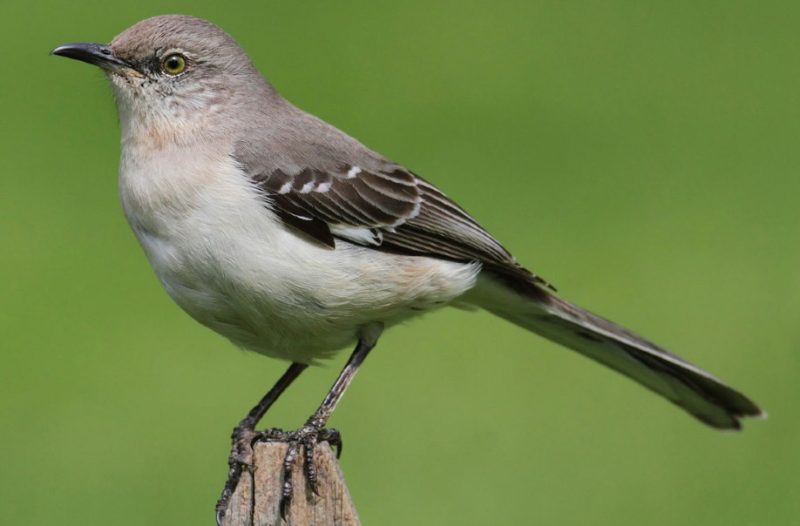
The Northern Mockingbird (Mimus polyglottos) is a sleek, gray songbird known for its unmatched vocal abilities and bold personality. It has a slender build, pale gray upperparts, a whitish underside, and long tail feathers edged in white. When it flies, it flashes large white wing patches that are striking and diagnostic. These birds are 8.3–10.2 inches in length with a wingspan of 12–15 inches.
Found year-round across Oklahoma, the Northern Mockingbird thrives in suburban yards, parks, open woodlands, and fields. It is a master mimic, capable of imitating the songs and calls of dozens of other bird species, as well as mechanical noises. Mockingbirds are territorial, often defending their nests with fearless aerial displays and sharp alarm calls. They feed on insects in summer and switch to berries and fruits in colder months.
A fun fact is that a single Northern Mockingbird can have a repertoire of over 200 different sounds. Males often sing throughout the night during the breeding season, especially if they are still searching for a mate. Their creativity, intelligence, and fearlessness make them one of the most charismatic birds in Oklahoma’s backyards and gardens.
Black-capped Chickadee
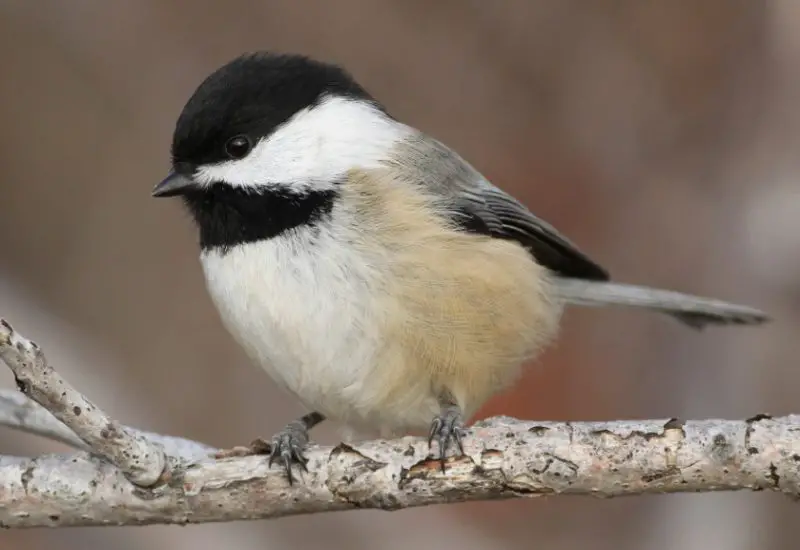
The Black-capped Chickadee (Poecile atricapillus) is a small, energetic songbird with a big personality. It is easily recognized by its black cap and bib, white cheeks, and soft gray back and wings. Its short neck and large head give it a round, fluffy appearance. Measuring just 4.7–5.9 inches long with a wingspan of 6.3–8.3 inches, this chickadee is both tiny and hardy.
In Oklahoma, the Black-capped Chickadee is most common in the northern parts of the state, particularly in deciduous and mixed woodlands. It’s a year-round resident, often found flitting through branches or hanging upside-down as it forages for insects, seeds, and berries. These birds frequently visit backyard feeders, especially during winter, and are known to cache food in hidden spots to retrieve later.
A charming fact is that the chickadee’s namesake “chick-a-dee-dee” call varies in intensity and number of “dees” depending on the perceived level of threat. They are highly social and intelligent birds, capable of remembering hundreds of food storage locations. In Oklahoma forests, they bring life and curiosity to cold, quiet winter days.
Belted Kingfisher

The Belted Kingfisher (Megaceryle alcyon) is a stocky, blue-gray bird with a shaggy crest and a thick, dagger-like bill. It has a white collar and underparts, with a blue breast band in males and an additional rufous band on the belly in females—the rare case in birds where the female is more colorful. These birds are about 11–14 inches in length with a wingspan of 19–23 inches.
Belted Kingfishers are found near rivers, lakes, ponds, and streams across Oklahoma, especially where perches overlook open water. They hunt by diving headfirst into water to catch fish, their primary food source, along with crustaceans and insects. They nest in burrows dug into sandy or earthen banks, sometimes over 3 feet long, where they lay their eggs in a chamber at the end.
A fascinating fact is that Belted Kingfishers have two fused toes—an adaptation that helps them dig efficiently. Their loud, rattling call is often heard before they’re seen, flying along watercourses with rapid wingbeats and hovering briefly before a dive. In Oklahoma, their presence is a familiar sight near waterways throughout most of the year.
Cedar Waxwing
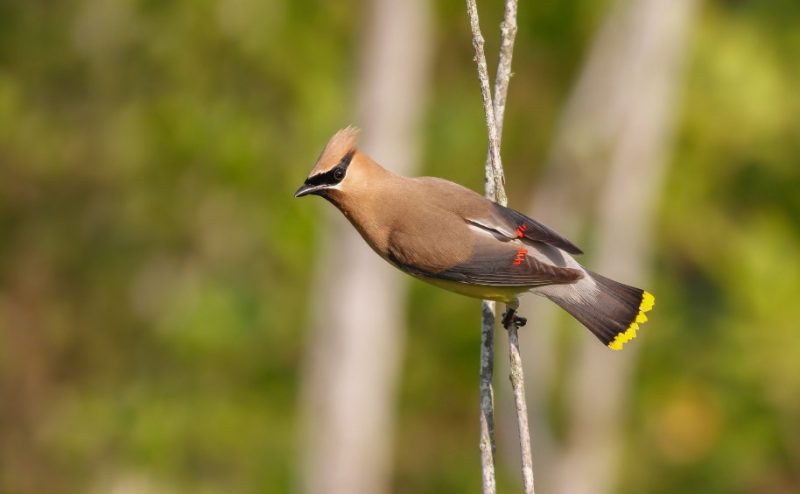
The Cedar Waxwing (Bombycilla cedrorum) is a sleek, elegant songbird with silky plumage, a crest, and a black mask across its face. Its coloring is a smooth blend of gray, brown, and pale yellow, with a bright yellow tail tip and red wax-like tips on the secondary wing feathers. These birds are about 6–7 inches long with a wingspan of 8.7–11.8 inches.
Cedar Waxwings are nomadic and found across Oklahoma, especially in areas with fruiting trees and shrubs. They feed mainly on berries and fruits year-round but will also catch flying insects in summer. These birds are highly social and often seen in flocks, sometimes passing berries from one bird to another in a chain. They nest in trees during the warmer months, with both parents sharing duties.
One fun fact is that the pigments from berries can sometimes tint the birds’ tail tips orange instead of yellow. Their high-pitched, thin “zee” calls are subtle and often the only sign of a nearby flock. Their gentle nature, striking appearance, and synchronized group behavior make them a treasured sight in Oklahoma during migration and in winter feeding flocks.
Song Sparrow
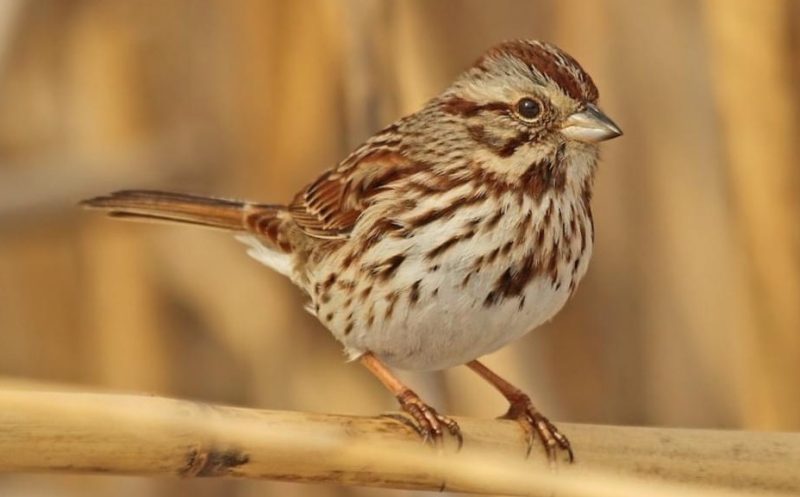
The Song Sparrow (Melospiza melodia) is a medium-sized, streaky brown sparrow with a rounded head, long tail, and a distinctive dark spot in the center of its chest. Its plumage varies regionally, but most individuals in Oklahoma display bold brown streaks on a pale background and a grayish face with a brown eye stripe. Measuring about 5–7 inches long with a wingspan of 7.1–9.4 inches, this bird blends well into brushy habitats.
Song Sparrows are found throughout Oklahoma during migration and winter, with some lingering in the northeastern parts year-round. They favor dense shrubs, thickets, and the edges of wetlands, where they forage on the ground for seeds and insects. True to their name, males sing rich, melodious songs composed of trills and varied phrases, often from exposed perches to defend territory and attract mates.
A fun fact about Song Sparrows is that no two males sing exactly the same song—they each develop a unique repertoire influenced by their environment. Their adaptability to various habitats makes them one of the most widespread and familiar sparrows across North America. In Oklahoma, they are especially noticeable in brushy areas during winter and early spring.
American Goldfinch
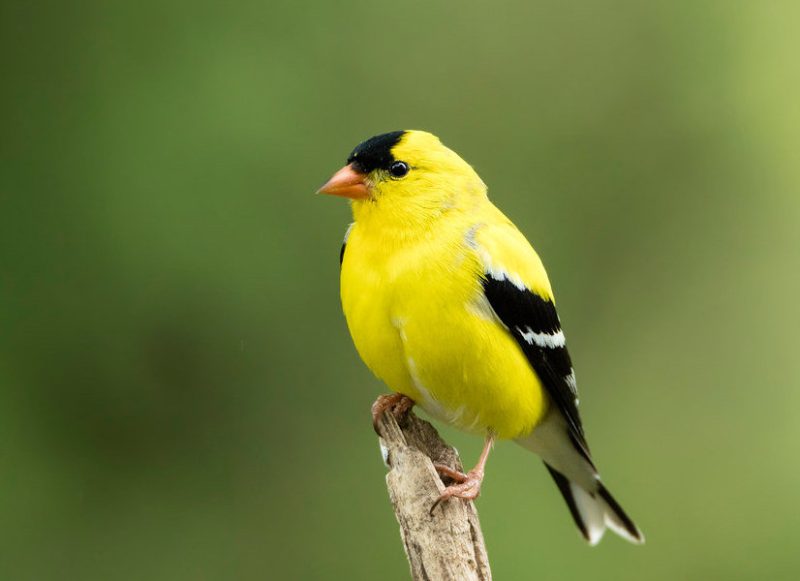
The American Goldfinch (Spinus tristis) is a small, vibrant songbird known for its bouncing flight and cheerful song. Breeding males are a brilliant yellow with black wings, forehead, and tail, while females and non-breeding males are a duller olive-yellow with similar black markings. These finches measure 4.3–5.1 inches in length with a wingspan of 7.5–8.7 inches.
In Oklahoma, American Goldfinches are year-round residents, though they are more visible during the breeding season in summer meadows and gardens. They feed primarily on seeds, especially from sunflowers, thistles, and dandelions, and are frequent visitors to backyard feeders offering nyjer or sunflower seeds. Unique among songbirds, they breed late in the season to coincide with peak seed availability.
One fun fact is that goldfinches undergo a complete molt in late summer, changing dramatically in appearance between seasons. Their flight is a distinctive roller-coaster motion accompanied by a sweet “per-chick-o-ree” call. Their social behavior and bright color make them a welcome sight in Oklahoma landscapes, from rural roadsides to suburban backyards.
Eastern Kingbird
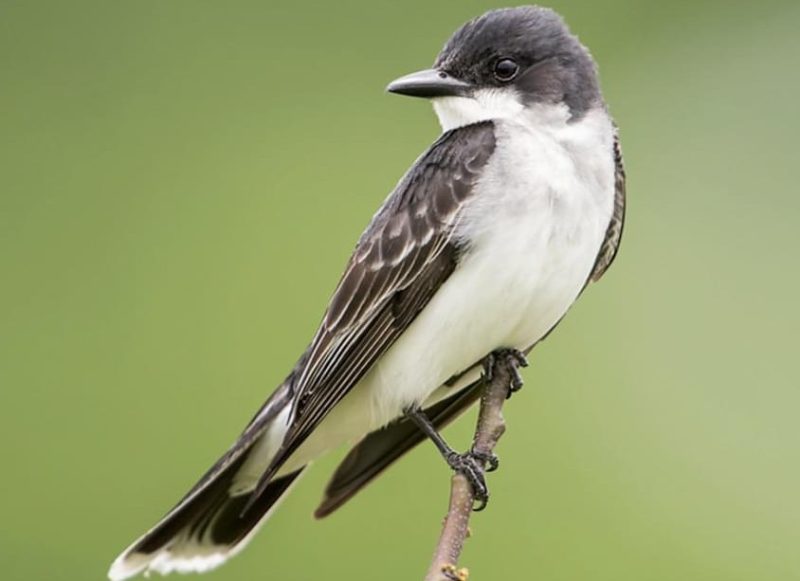
The Eastern Kingbird (Tyrannus tyrannus) is a medium-sized, sturdy flycatcher with bold plumage and an upright posture. It is mostly slate gray above and white below, with a black head that subtly contrasts with its dark back. The bird’s squared tail has a noticeable white tip. Adults are about 7.5–9.1 inches long, with a wingspan of 13–15 inches.
Eastern Kingbirds are summer breeders across Oklahoma, commonly seen perched on fences or branches overlooking open fields, pastures, or ponds. They are aerial insectivores, catching flying insects with quick, acrobatic flights. Despite their size, they are highly territorial and will aggressively chase away much larger birds—sometimes even hawks or crows—from their nesting area.
A unique fact is that Eastern Kingbirds have a hidden red-orange crown patch, which they raise when agitated or during courtship. Their call is a sharp, sputtering “kit-kit-kit” often heard as they patrol their territory. In Oklahoma, they add energy and drama to summer fields with their fearless behavior and constant activity.
Chipping Sparrow
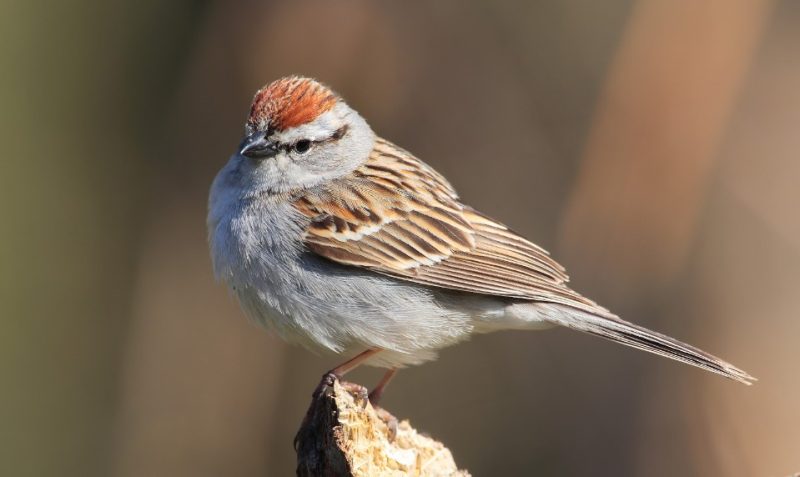
The Chipping Sparrow (Spizella passerina) is a small, slim sparrow with a clean, crisp appearance. During breeding season, it’s easy to recognize by its bright rufous cap, white eyebrow, and black eye line. The body is mostly gray with light streaks on the back and wings. These birds measure 4.7–5.9 inches long with a wingspan of 8.3 inches.
Chipping Sparrows are common in Oklahoma during spring and summer, where they breed in open woods, residential areas, and parks. They are ground foragers, feeding on seeds and small insects, and frequently visit bird feeders. Their nests are small, cup-shaped structures placed in shrubs or trees, often just a few feet off the ground.
A fun fact is that Chipping Sparrows get their name from their high-pitched, dry “chip” call, which is a key part of their song. Their simple trill is often mistaken for insect noise, especially during hot summer days. These tiny birds are among the first to arrive in Oklahoma each spring and are one of the most widespread and familiar sparrows in suburban settings.
Killdeer
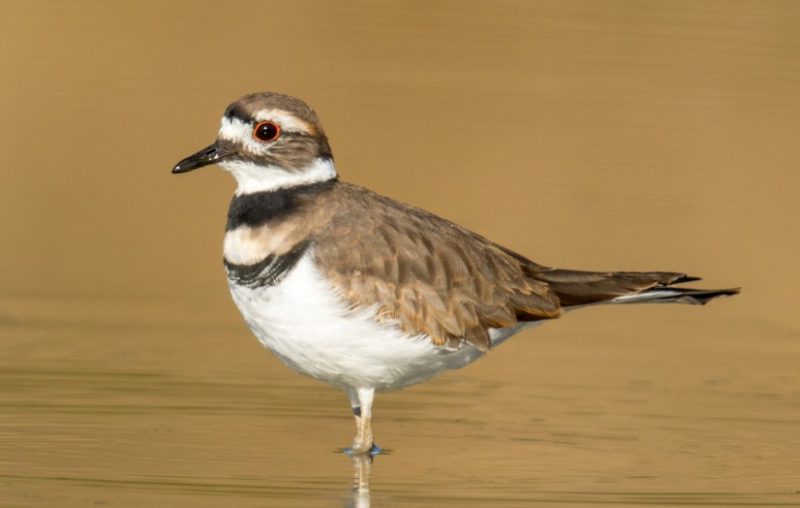
The Killdeer (Charadrius vociferus) is a medium-sized plover known for its loud, piercing “kill-deer” call and dramatic distraction displays. It has a slender build, brown back, white belly, and two distinctive black bands across its chest. The bright orange tail and rump flash during flight. Adults measure 7.9–11 inches in length with a wingspan of 18–19 inches.
Killdeer are widespread year-round residents across Oklahoma, often seen in open habitats such as gravel roads, fields, shorelines, and even parking lots. Unlike many shorebirds, they are just as comfortable far from water. They nest directly on the ground, creating shallow scrapes lined with pebbles. When threatened, adults perform the famous “broken-wing” act to lure predators away from their nests.
An interesting fact is that Killdeer chicks are precocial—they hatch fully feathered and can run shortly after emerging from the egg. These birds are vocal, highly alert, and often active at dawn and dusk. Their distinctive behavior, bold markings, and adaptability make them one of the most recognizable ground-nesting birds in Oklahoma.
Turkey Vulture
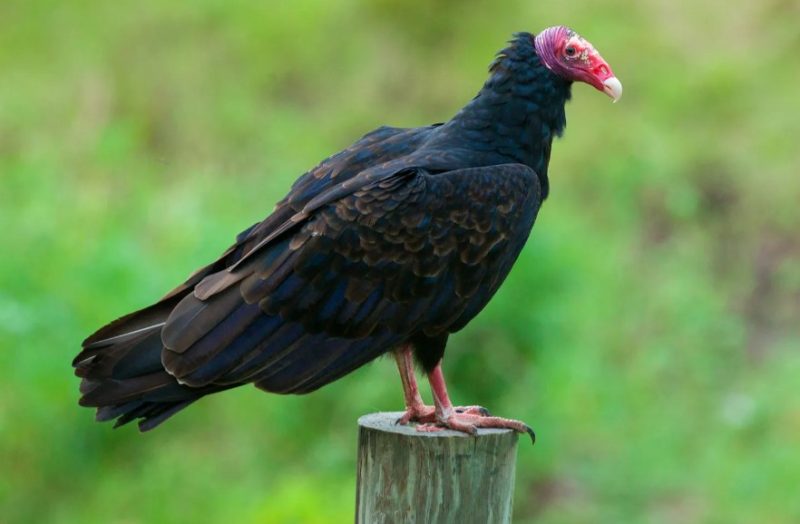
The Turkey Vulture (Cathartes aura) is a large scavenging bird known for its dark plumage, broad wings, and featherless red head. Its body is mostly brownish-black, with a two-toned wing pattern—dark in front and silver-gray behind—visible in flight. It measures about 25–32 inches in length, with an impressive wingspan of 63–72 inches, making it one of the largest birds regularly seen soaring over Oklahoma.
Turkey Vultures are widespread throughout Oklahoma and are commonly seen gliding effortlessly over open areas, roadsides, and fields, searching for carrion. They have an extraordinary sense of smell—unusual for birds—that allows them to detect decaying animals from great distances. Despite their somewhat ominous appearance, they play a vital role in ecosystems by cleaning up dead animals. They roost communally and are often seen sunning themselves with wings spread wide in a “horaltic” pose.
A fascinating fact is that Turkey Vultures use thermal currents to stay aloft with minimal wing flapping, often soaring for hours without flapping once. Unlike most raptors, they wobble side to side in flight and hold their wings in a shallow “V” shape. In Oklahoma, they are most visible in spring and summer but may linger year-round in the southern part of the state.
Barred Owl
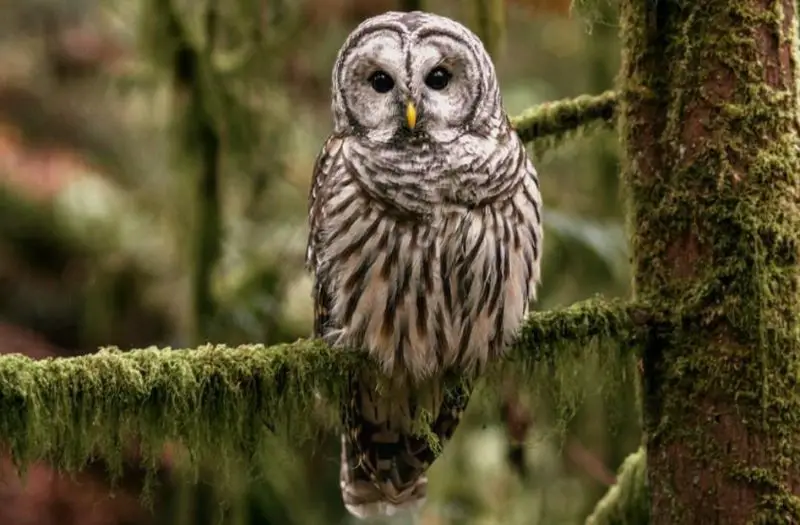
The Barred Owl (Strix varia) is a large, round-headed owl known for its soulful eyes and haunting call. Its plumage is mottled brown and white with horizontal barring on the chest and vertical streaking on the belly. Unlike many owls, it has deep brown eyes instead of yellow. Adults measure 16–25 inches in length with a wingspan of 38–49 inches.
This nocturnal raptor is found in mature forests across eastern and central Oklahoma, often near water or dense woodland. Barred Owls are opportunistic hunters, feeding on small mammals, birds, amphibians, and invertebrates. They nest in tree cavities and are very vocal, with a distinctive hooting call described as “Who cooks for you? Who cooks for you all?” echoing through quiet forests at night.
A remarkable fact is that Barred Owls can rotate their heads up to 270 degrees thanks to extra neck vertebrae. Though primarily nocturnal, they are sometimes active during the day, especially when raising young. In Oklahoma, their eerie yet beautiful calls and ghostly flight through wooded areas make them a mystical presence in natural landscapes.
Purple Martin
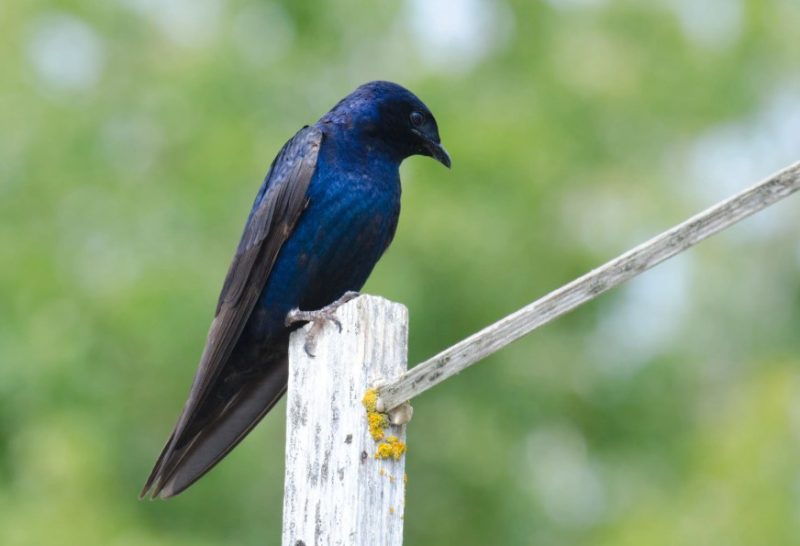
The Purple Martin (Progne subis) is the largest swallow in North America and a beloved backyard bird for its aerial acrobatics and insect-eating habits. Adult males are glossy blue-black all over, while females and juveniles are duller with grayish underparts. They measure about 7.5–8.7 inches in length with a wingspan of 15–16 inches.
Purple Martins are migratory and breed across much of Oklahoma during spring and summer. They have a strong association with human habitation in the eastern U.S., relying almost entirely on man-made birdhouses or gourd colonies for nesting. These highly social birds form large colonies and feed on flying insects, such as mosquitoes, flies, and beetles, which they catch in mid-air using graceful swoops and dives.
One fun fact is that Purple Martins migrate thousands of miles each year between Oklahoma and South America. Landowners often compete to attract them with elaborate houses, as martins are known to return to the same sites each year. Their cheerful chatter and darting flight patterns bring life and energy to Oklahoma gardens and rural homesteads from late March through early August.
Cliff Swallow
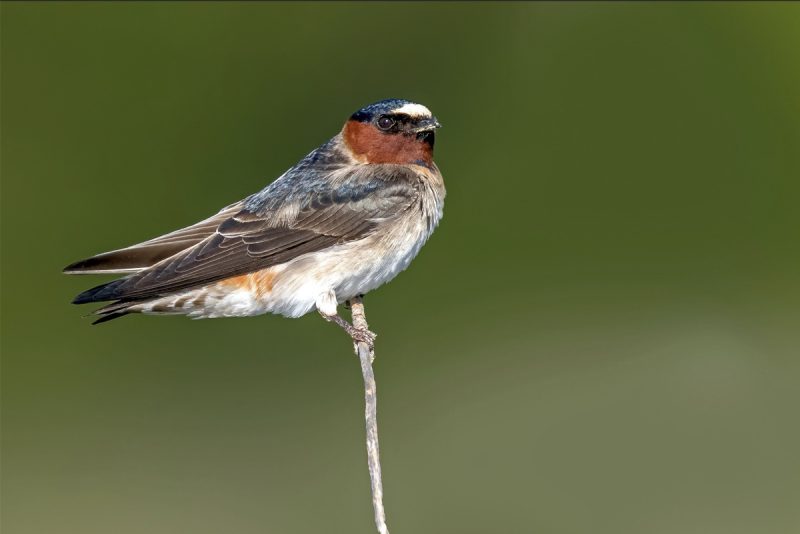
The Cliff Swallow (Petrochelidon pyrrhonota) is a small, agile bird known for its communal nesting and gourd-shaped mud nests. It has a dark blue back, a pale underbelly, a buff-colored rump, and a distinct white forehead patch. Its square tail helps differentiate it from other swallows. Cliff Swallows are about 5.1 inches long with a wingspan of 11–11.8 inches.
In Oklahoma, Cliff Swallows are summer residents, building their nests on vertical surfaces under bridges, overpasses, cliffs, and buildings. They gather in large colonies and construct nests out of hundreds of mud pellets, often placing them side by side in dense clusters. These swallows feed on flying insects, which they catch in swift, graceful flight above fields, rivers, and open areas.
A fascinating fact is that Cliff Swallows are known for their remarkable homing abilities—they often return to the exact colony site or even the same nest from the previous year. Their “cheer-cheer” calls and synchronized movements make their nesting colonies both noisy and lively. In Oklahoma, they’re a familiar sight near highways and rivers throughout the warm months.
Great Blue Heron
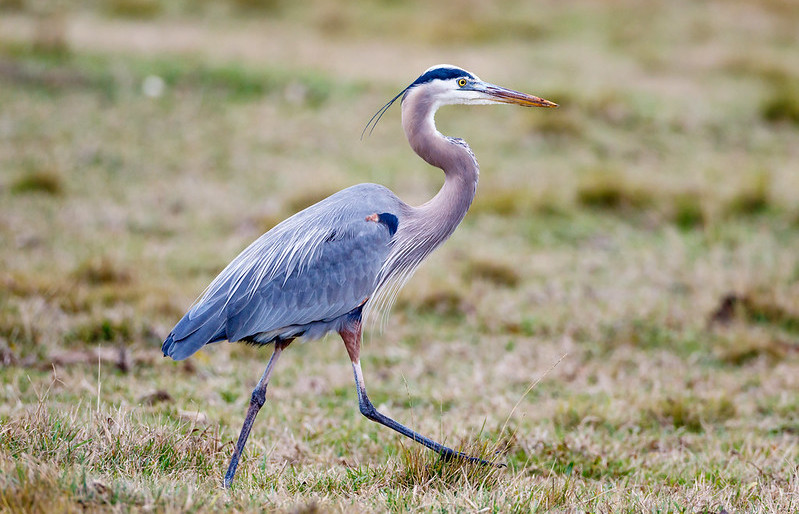
The Great Blue Heron (Ardea herodias) is the largest heron in North America and a familiar sight in wetlands and along water bodies in Oklahoma. It stands about 3.2–4.5 feet tall with a wingspan of up to 6.6 feet. Its plumage is primarily gray-blue, with a long neck, dagger-like bill, and black plumes above the eyes. In flight, it tucks its neck into an “S” shape and shows slow, deep wingbeats.
Great Blue Herons are year-round residents in Oklahoma, though northern populations may migrate south for the winter. They inhabit lakeshores, rivers, ponds, and marshes, where they hunt patiently by wading in shallow water. Their diet includes fish, amphibians, crustaceans, and even small mammals or birds. They nest in large stick platforms in tall trees, often forming colonies called heronries.
An impressive fact is that despite their large size, Great Blue Herons are incredibly stealthy hunters and can strike lightning-fast to capture prey. Their deep, croaking “fraaank” calls are commonly heard at dawn and dusk. In Oklahoma, these majestic birds symbolize the serene beauty of wetland habitats and are frequently spotted along waterways across the state.
Yellow-rumped Warbler
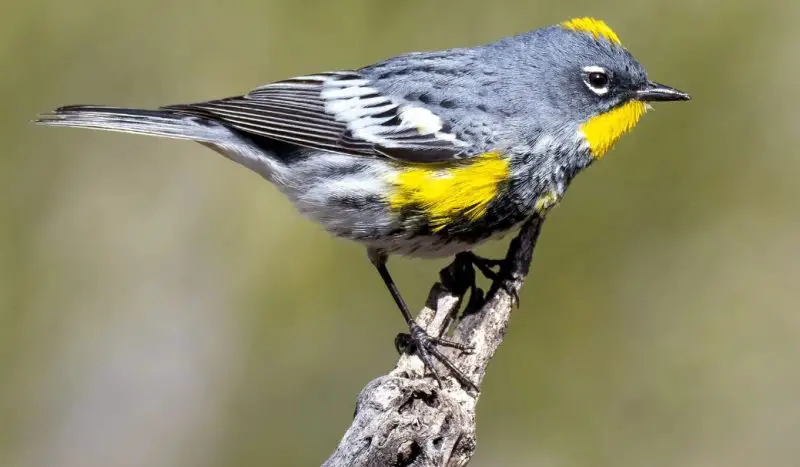
The Yellow-rumped Warbler (Setophaga coronata) is a small, active songbird known for its striking plumage and adaptability to different habitats. During breeding season, males sport slate-blue backs, bold black markings, white underparts, and bright yellow patches on the crown, flanks, and rump. In non-breeding plumage, both sexes appear duller but still show the characteristic yellow rump. These warblers measure 4.7–5.9 inches in length with a wingspan of 7.5–9.1 inches.
In Oklahoma, Yellow-rumped Warblers are most common during migration and winter, especially in woodlands, parks, and brushy edges. Unlike many warblers, they can survive colder months thanks to their ability to digest waxes in berries, particularly from bayberry and wax myrtle. They are often seen flitting through trees or shrubs in search of insects, occasionally fly-catching in midair.
A fun fact is that Yellow-rumped Warblers are sometimes nicknamed “butter butts” because of the bright yellow patch on their rump. Their high-pitched, musical trill is a familiar sound during spring migration. In Oklahoma, their presence brightens up winter landscapes, and they often gather in mixed flocks with kinglets, chickadees, and other small songbirds.
Eastern Phoebe
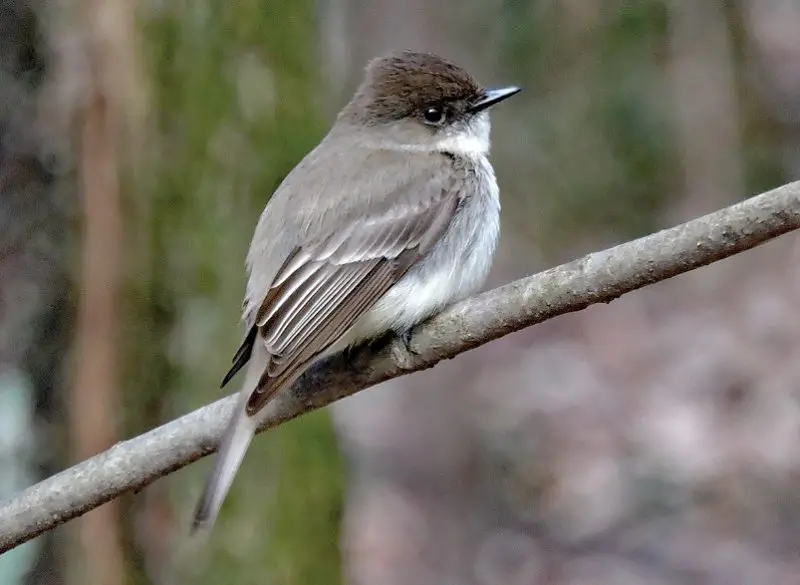
The Eastern Phoebe (Sayornis phoebe) is a small, flycatcher with a gentle, understated appearance and a constantly wagging tail. It has a grayish-brown back, white underparts, a dark head, and a straight, narrow bill. These birds measure about 5.5–6.7 inches in length with a wingspan of 10.2–11 inches. They lack the bold wingbars seen in some other flycatchers, making them easy to identify by behavior and call.
Eastern Phoebes are among the earliest migratory birds to return to Oklahoma in spring, often arriving as early as late February. They are frequently seen near buildings, bridges, and wooded streams, where they build nests of mud and moss on ledges. True to their flycatching nature, they perch quietly and dart out to catch insects midair before returning to the same spot.
A distinctive fact is that Eastern Phoebes often reuse nesting sites year after year and will even tolerate human activity nearby. Their raspy “fee-bee” call is a constant soundtrack during early spring mornings. In Oklahoma, these friendly and approachable birds are common in rural yards and wooded areas, often nesting under eaves or porch roofs.
Brown Thrasher

The Brown Thrasher (Toxostoma rufum) is a large, secretive songbird with a rich brown back, heavily streaked white underparts, a long slightly curved bill, and piercing yellow eyes. Its long tail and confident posture make it stand out in dense shrubs and thickets. It measures about 9–12 inches in length with a wingspan of 11–13 inches.
Brown Thrashers are common breeding birds across Oklahoma and prefer dense brush, hedgerows, woodland edges, and suburban thickets. They forage primarily on the ground, flipping leaf litter to uncover insects, seeds, and berries. Although shy, they are fiercely territorial during nesting season and will defend their nests aggressively.
A fun fact is that Brown Thrashers are exceptional mimics and have one of the largest song repertoires of any North American bird—some estimates suggest they can sing over 1,000 different song types. Their song is a series of repeated phrases, often delivered in pairs, and may include imitations of other birds. In Oklahoma, they are most often heard before they are seen, singing hidden within dense foliage.
Red-headed Woodpecker
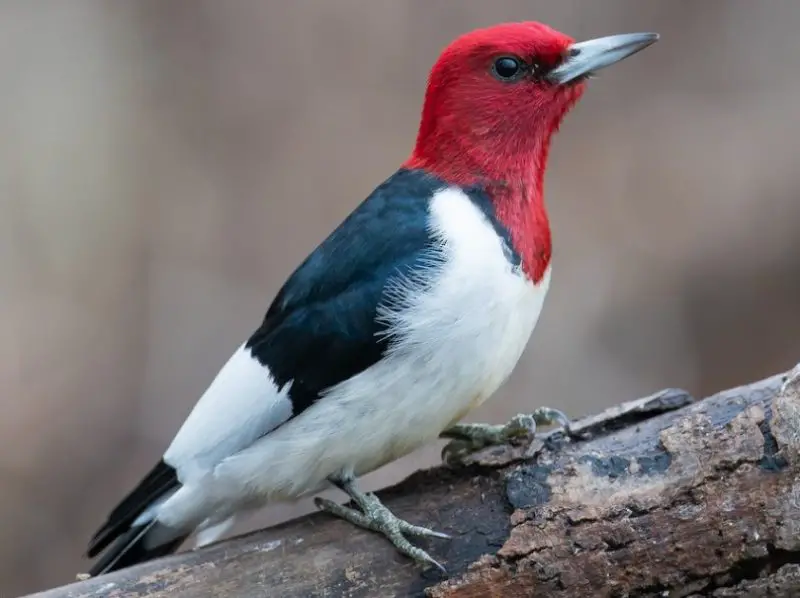
The Red-headed Woodpecker (Melanerpes erythrocephalus) is one of the most striking woodpeckers in North America, known for its vibrant crimson head, stark white belly, and bold black and white wings. Its clean, sharply contrasting coloration makes it easy to identify. Adults measure about 7.5–9.1 inches long with a wingspan of 16–17 inches.
In Oklahoma, Red-headed Woodpeckers are found in open woodlands, savannas, groves, and farmlands, often where dead trees are present. They are one of the few woodpeckers known to store food, such as insects and acorns, by wedging them into bark crevices. Their diet is varied and includes nuts, fruits, seeds, and small animals. They nest in tree cavities and may reuse old holes or excavate new ones.
A fascinating fact is that unlike most woodpeckers, Red-headed Woodpeckers can catch flying insects in midair. They are also known to remove the eggs or nestlings of other birds, which is rare behavior among woodpeckers. In Oklahoma, their numbers fluctuate but they are most reliably seen in areas with open canopy forests and standing deadwood.
Wild Turkey
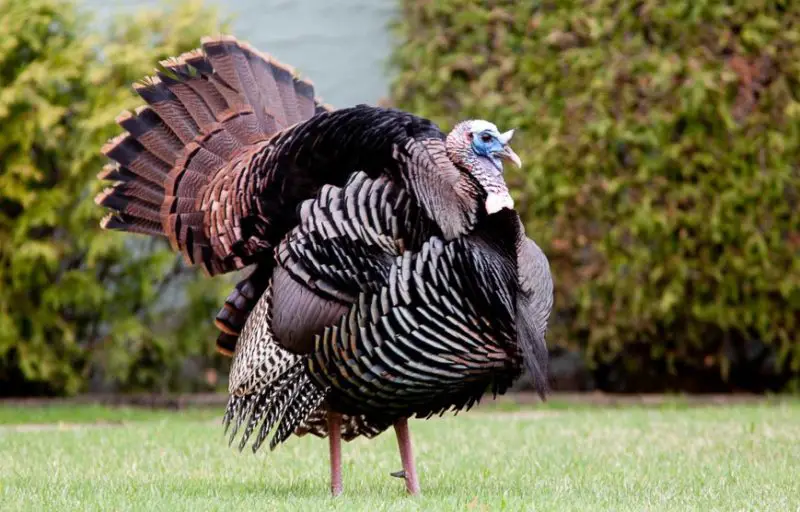
The Wild Turkey (Meleagris gallopavo) is a large, ground-dwelling bird with a fan-shaped tail, bare bluish-red head, and iridescent bronze body feathers. Males, or toms, are significantly larger than females and sport a beard-like tuft of feathers on their chest and sharp spurs on their legs. Adult turkeys measure about 36–44 inches long with a wingspan of 4.5–5 feet.
Wild Turkeys are native to Oklahoma and are commonly found in forests, woodlands, and open fields across the state. They forage by walking and scratching the ground for seeds, insects, and berries. In spring, males display by puffing out their feathers, fanning their tails, and gobbling to attract females. These gobbles can be heard over a mile away and are a defining sound of rural Oklahoma in spring.
One fascinating fact is that Wild Turkeys were nearly extirpated from much of their range due to overhunting and habitat loss but have made a strong comeback thanks to conservation efforts. They are strong fliers for short distances and can roost in trees overnight. In Oklahoma, turkeys are a symbol of both wilderness and conservation success, often seen strutting across fields or disappearing into wooded terrain.
White-winged Dove

The White-winged Dove (Zenaida asiatica) is a medium-sized dove easily recognized by the broad white edge on its wings, which is especially visible in flight. Its overall color is light grayish-brown, with a blue skin patch around the eye and a short, square-tipped tail. Adults typically measure 11–12 inches long with a wingspan of about 18 inches.
These doves are expanding their range and are now common summer residents in southern and central Oklahoma. They prefer open woodlands, urban parks, agricultural areas, and desert-like habitats with mesquite or prickly pear cactus. Their diet includes seeds, grains, and fruits, and they frequently visit backyard feeders. During nesting season, they build flimsy twig nests in trees, shrubs, or even on man-made structures.
A fun fact about White-winged Doves is that their song sounds like “who-cooks-for-you” and can be heard repeatedly during the breeding season. They were once considered primarily southwestern birds, but climate adaptation and feeding opportunities have allowed them to move farther north. In Oklahoma, their growing presence adds a touch of the tropics to summer birdlife.
Broad-winged Hawk
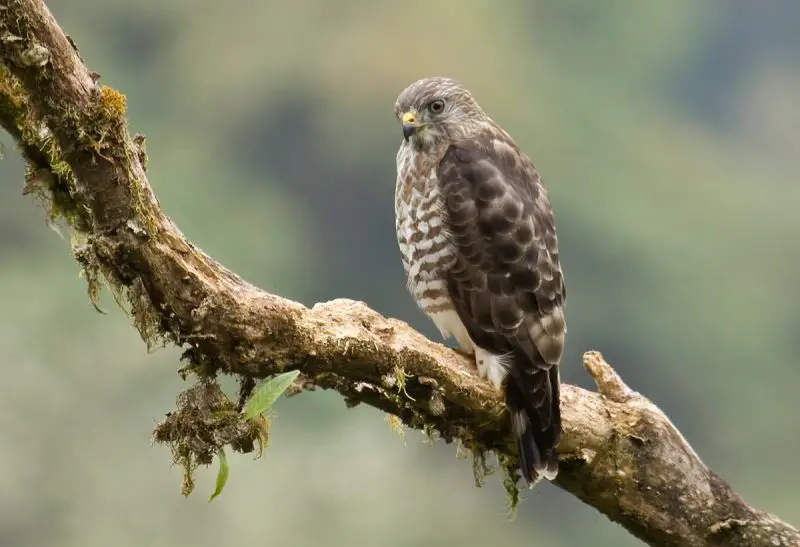
The Broad-winged Hawk (Buteo platypterus) is a small, compact raptor with broad wings and a short tail banded with thick black and white stripes. Its back is dark brown, and the chest is pale with reddish barring. These hawks measure about 13–17 inches in length with a wingspan of 31–39 inches, making them one of the smaller Buteo species.
In Oklahoma, Broad-winged Hawks are primarily seen during spring and fall migration, though some breed in the eastern woodlands of the state. They favor deciduous forests and wooded river corridors, where they hunt small mammals, amphibians, and insects. These hawks are more secretive than other raptors and often perch quietly beneath the forest canopy.
An exciting fact is that Broad-winged Hawks form massive flocks called “kettles” during migration—sometimes numbering in the thousands—which can be seen spiraling high in the sky. Their high-pitched whistle, “kee-eee,” is often heard in forests during breeding season. In Oklahoma, they offer one of the state’s most impressive raptor migration spectacles during late September.
Pileated Woodpecker
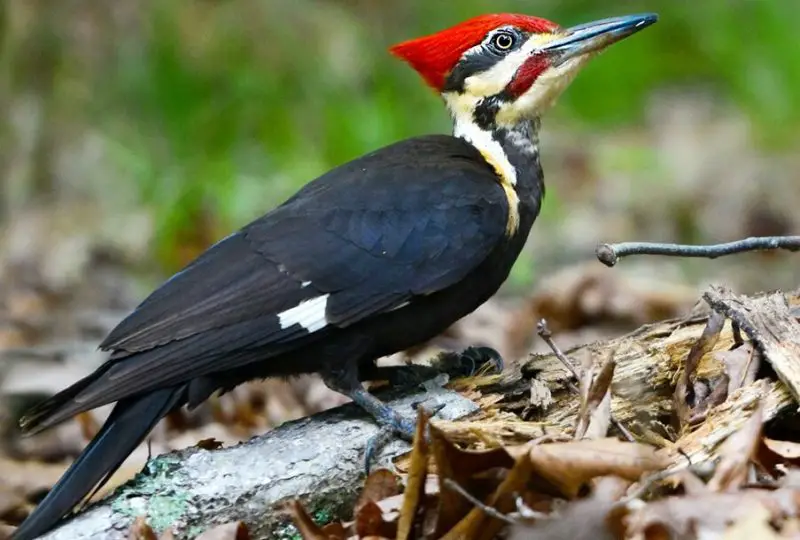
The Pileated Woodpecker (Dryocopus pileatus) is the largest woodpecker in North America outside of the Ivory-billed. It has a striking black body with white stripes down the face and neck, and a flaming red crest that gives it a prehistoric look. Males also have a red “mustache” mark. These woodpeckers measure about 16–19 inches long with a wingspan of 26–30 inches.
Pileated Woodpeckers are found in mature forests across eastern Oklahoma, particularly in areas with large, decaying trees. They excavate deep, rectangular holes in deadwood while searching for carpenter ants and other insects. These cavities are used by other wildlife after the woodpeckers abandon them. Their loud, echoing calls and wild, laughter-like drumming make them easy to detect even if not seen.
A fun fact is that the cartoon character Woody Woodpecker was inspired by this species. Pileated Woodpeckers are powerful excavators, and their hammering can be heard from a great distance. In Oklahoma, spotting one is always a thrill, and their presence often indicates a healthy, mature forest ecosystem.
Swainson’s Hawk
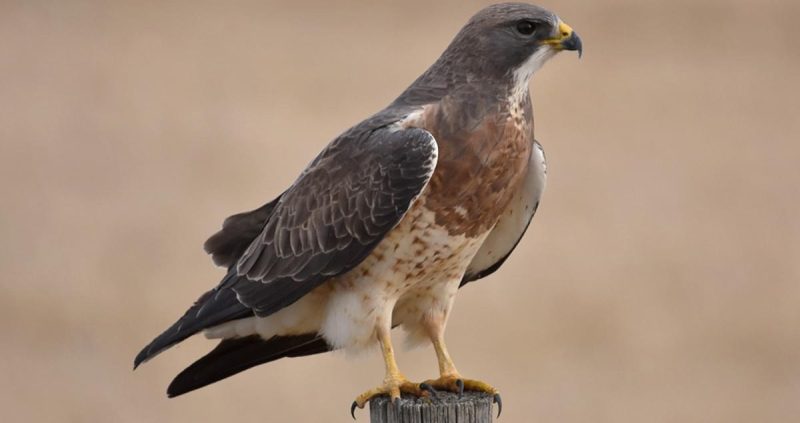
Swainson’s Hawk (Buteo swainsoni) is a large, long-winged raptor known for its graceful flight and long-distance migrations. Adults usually have a light underbelly with a contrasting dark brown chest, though color morphs exist. The wings are long and pointed compared to other Buteo hawks. These birds measure 18–22 inches in length with a wingspan of 46–54 inches.
In Oklahoma, Swainson’s Hawks are seen during spring and fall migration and occasionally breed in the western parts of the state. They favor open grasslands, prairies, and agricultural fields, where they hunt small mammals, reptiles, and insects. They are especially known for feeding on grasshoppers and dragonflies in late summer.
An incredible fact is that Swainson’s Hawks migrate over 6,000 miles each year to wintering grounds in Argentina, making one of the longest migrations of any raptor. In Oklahoma, they can be seen soaring over open country in kettles during migration, often sharing the sky with Broad-winged Hawks and Turkey Vultures.
Ruby-throated Hummingbird

The Ruby-throated Hummingbird (Archilochus colubris) is a tiny, iridescent bird with a dazzling green back and, in males, a brilliant ruby-red throat. Females lack the red throat and are more subtly colored. These hummingbirds measure only 2.8–3.5 inches long with a wingspan of about 3.1–4.3 inches, and they weigh less than a penny.
In Oklahoma, Ruby-throated Hummingbirds are common summer residents, arriving in April and departing by late September. They are drawn to flowering plants and feeders with sugar water, zipping from bloom to bloom with rapid wingbeats. Males perform U-shaped aerial displays to attract females, and females build tiny, cup-shaped nests using spider silk and plant fibers.
A fascinating fact is that despite their size, Ruby-throated Hummingbirds migrate solo across the Gulf of Mexico—nonstop—for up to 500 miles. Their wings beat about 50 times per second in flight, producing a humming sound that gives them their name. In Oklahoma gardens, they bring brilliant flashes of color and energy to the summer landscape.
FAQs About 45 Common Birds in Oklahoma
What are some of the most common birds found in Oklahoma?
Some of the most common birds include the Northern Cardinal, American Robin, Blue Jay, Mourning Dove, and Red-tailed Hawk. These species are seen year-round or seasonally across various habitats in Oklahoma.
When is the best time to go birdwatching in Oklahoma?
The best time is during spring and fall migrations when many species pass through the state. Early mornings in spring and summer are also great for spotting breeding birds.
How can I identify different bird species in Oklahoma?
Identification can be based on size, color patterns, songs or calls, behaviors, and habitat. Using a bird guidebook or app with pictures and sounds can be very helpful.
Are there any endangered or threatened birds in Oklahoma?
Yes, some birds like the Lesser Prairie-Chicken face threats due to habitat loss. Conservation efforts are ongoing to protect these species and their habitats.
Can I attract common Oklahoma birds to my backyard?
Absolutely! Providing food like seeds, suet, and nectar, along with water and shelter, can attract many local birds such as finches, woodpeckers, and hummingbirds.

